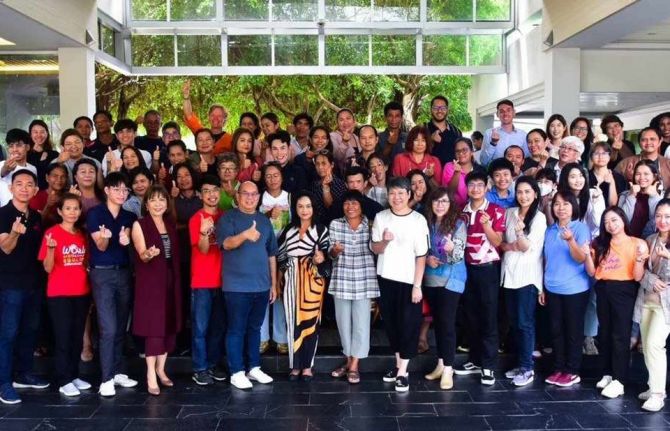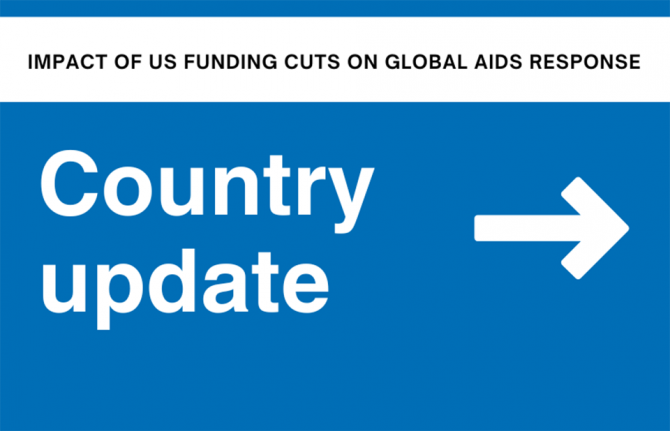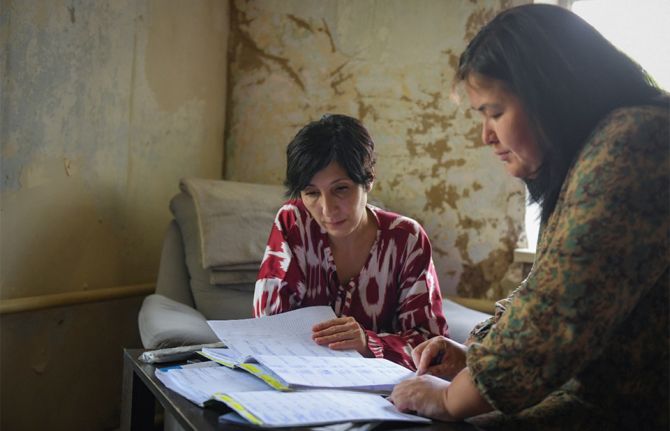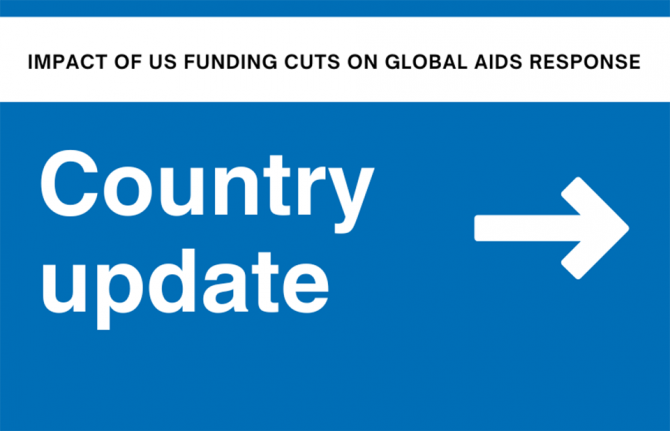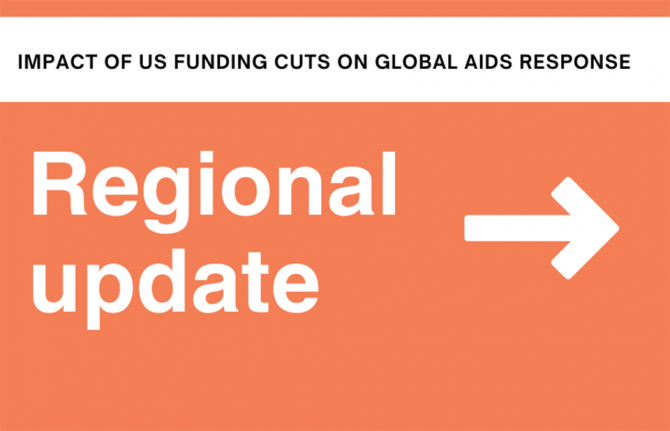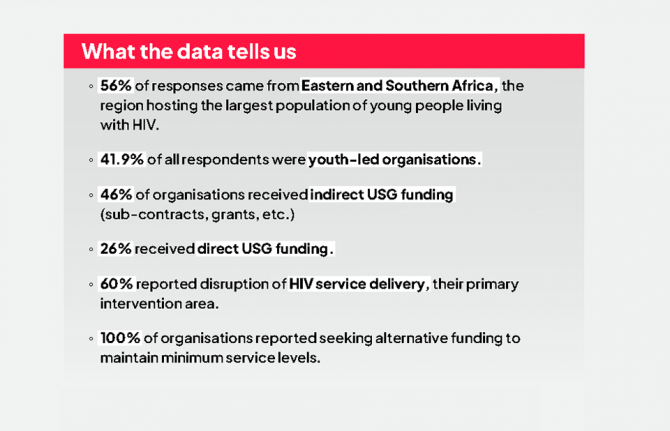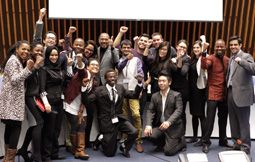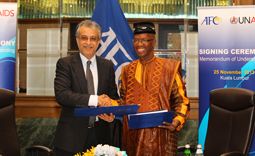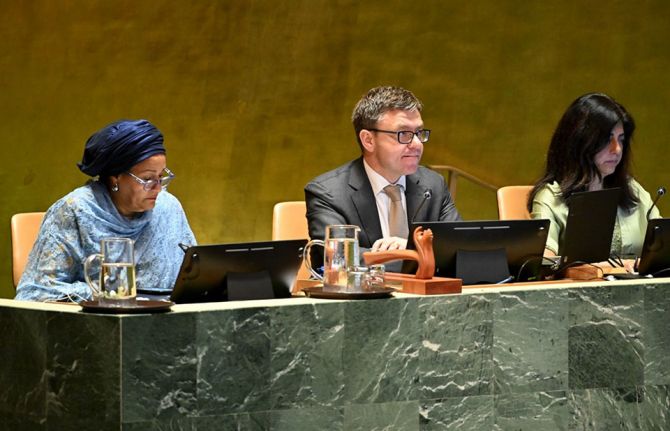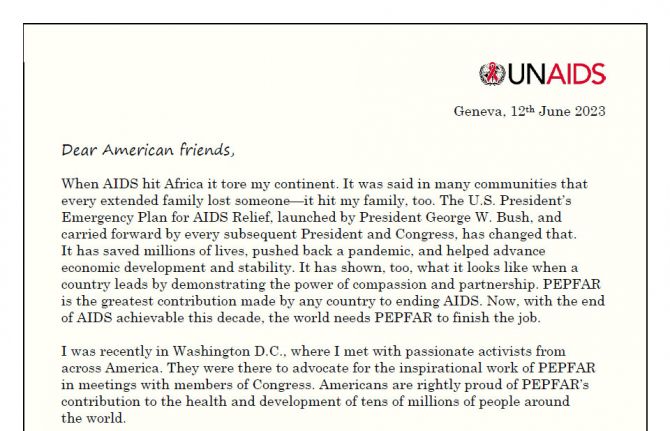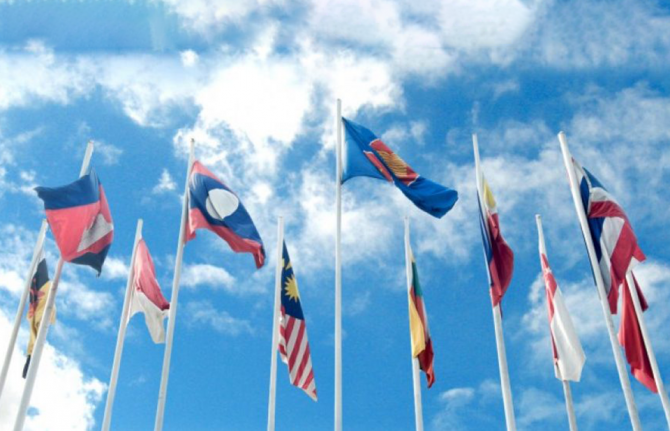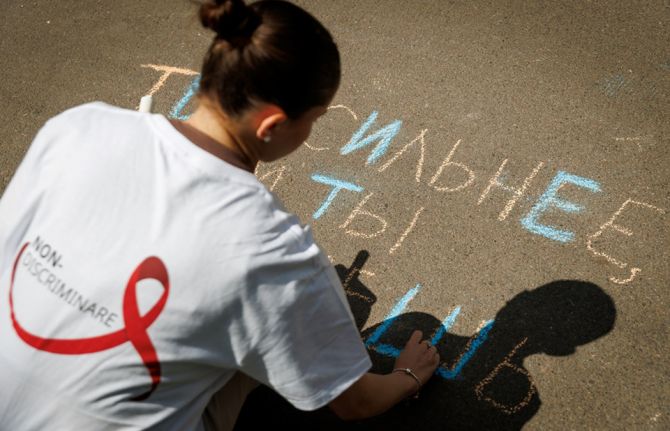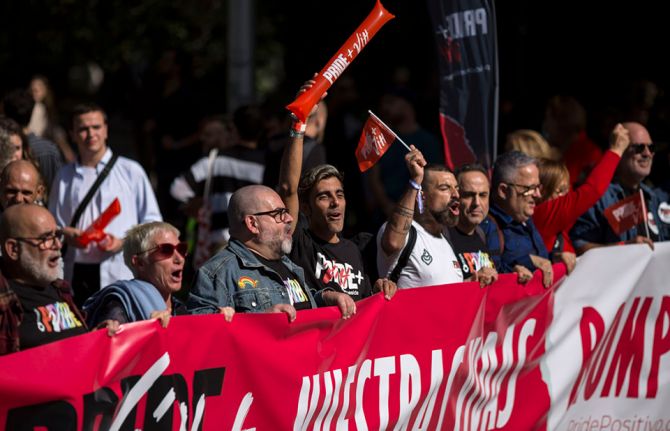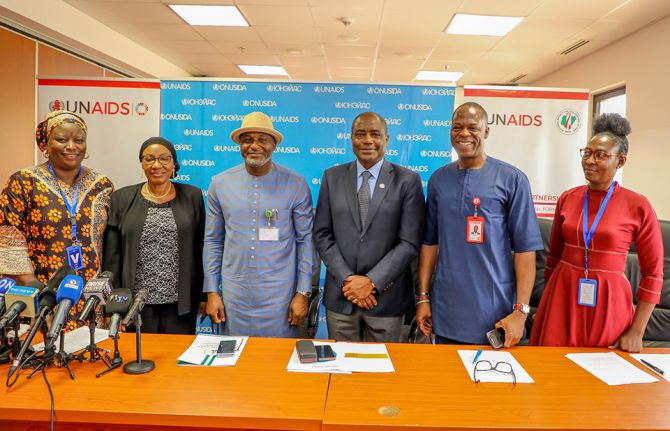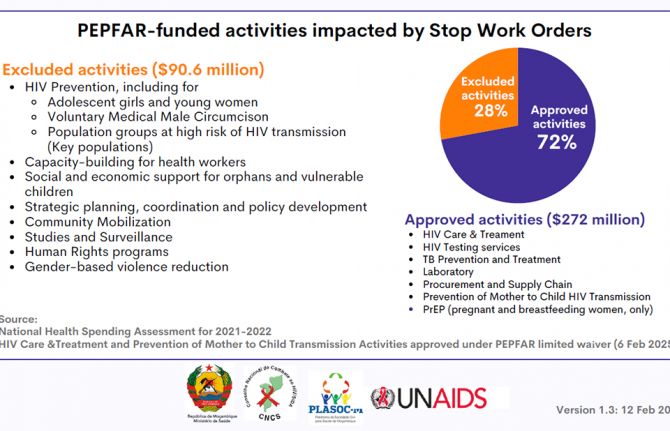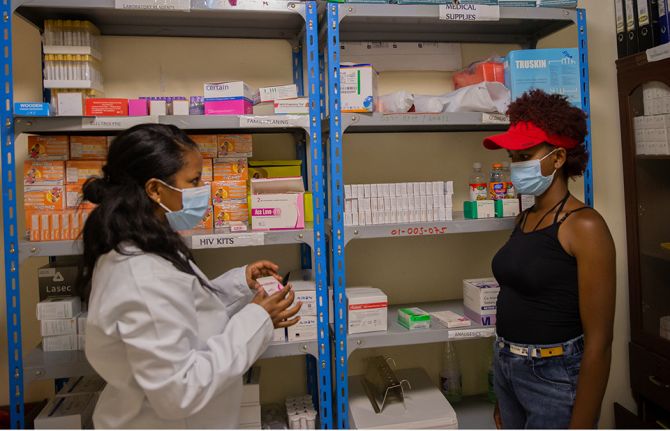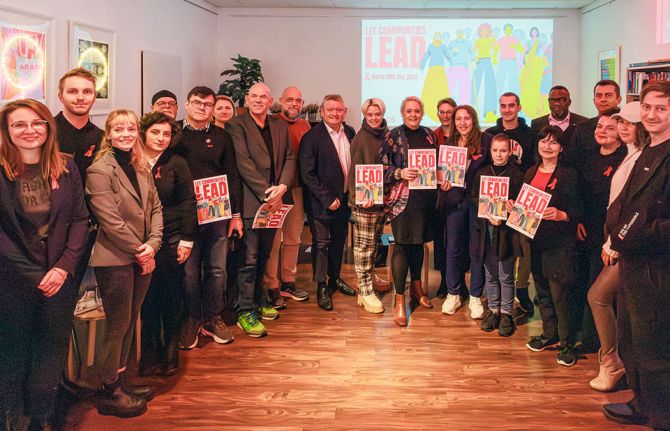
Feature Story
Universal access: target setting in Asia and the Pacific
27 October 2006
27 October 2006 27 October 2006Less than six months after the United Nations Member States endorsed the 2006 Political Declaration on HIV/AIDS, countries across the world have started setting ambitious targets to significantly scale up their response to AIDS. This is the first step to moving towards the goal of universal access to comprehensive HIV prevention, treatment, care and support by 2010.
We asked Mr Prasada Rao, UNAIDS Regional Support Team Director for Asia and the Pacific to update us on progress in his region.
In June 2006 the UN Member States committed to significantly scale up their AIDS response in the bid to achieving the goal of universal access to HIV prevention, treatment, care and support by 2010. What can we say about this process in Asia and the Pacific?
Countries in Asia and the Pacific have made significant progress and taken concrete actions on the commitments made in New York. Since the first regional consultation that took place in February 2006 to identify obstacles to moving towards the goal of universal access by 2010, a number of national and regional consultations have been held to discuss the different aspects of this process and put in place mechanisms to move forwards, including developing targets, and updating and costing strategic plans. The consultation held on 25 August, immediately after the Toronto AIDS Conference, focused specifically on how to ensure civil society involvement in the universal access process in the region. More recently, a consultation took place between 24 and 27 October in Ulaanbaatar, Mongolia, which brought together government, civil society, bilateral and UN representatives from 11 low-prevalence countries in the region.
Can you give us concrete examples of what has happened in Asia and the Pacific after the 2006 Political Declaration was endorsed?
Countries such as Cambodia, India, Philippines, Nepal and Thailand have already agreed on targets. It’s important to note that they have set targets in three programmatic areas: prevention, treatment and care and support. It’s also important to note that these countries have assessed the resources needed to achieve the new targets.
Can you tell us how these targets have been set?
One of the specificities of the process of scaling up a comprehensive response to HIV towards the goal of universal access by 2010 is that it should be driven by local realities and should include all stakeholders, in particular civil society. This means that no two countries followed the same process. However, we worked with all countries and involved stakeholders to re-visit the targets set in the Declaration of Commitment in 2001, in light of their actual performance and their current capacity. The purpose of this exercise is to consider setting ambitious targets for countries making good progress and for countries which are not as successful, to explore the reasons why and identify the concrete obstacles that are hindering progress. This also gives countries an opportunity to improve harmonization and alignment of partners’ efforts with their national AIDS strategies, as recommended by the Global Task Team.
What about the other countries in the region?
Bangladesh , Indonesia, China, Laos, Viet Nam, Myanmar and Sri Lanka are making progress but at a slower rate. In these countries, governments are committed to moving forwards and UNAIDS is working with them, and with representatives from civil society, to evaluate if the targets are ambitious enough, while remaining realistic and feasible. We are expecting to complete this process by the end of 2006 as set out in the Political Declaration.
In other smaller, low prevalence countries in Asia and the Pacific, we are working closely with country representatives to accelerate the target setting process. The response from these countries has been extremely positive.
What are some of the challenges countries are facing in Asia and the Pacific in setting targets?
Harmonizing the target setting process with ongoing planning processes is definitely a challenge. However, I have to say that several countries have been able to overcome this. For example in Nepal, the National Strategic Plan for 2006/7-2010/11 is being developed and will contain quantitative targets for scaling up prevention and treatment towards universal access. India and Pakistan have also incorporated the target setting process in their national planning process.
In the Political Declaration, countries commit to setting the new targets through consultations with all stakeholders involved in the AIDS response, including people living with HIV. Can we see this happening in Asia and the Pacific?
Ensuring the significant contribution of civil society, particularly people living with HIV in the target setting process is another challenge in the region and a critical element of the commitment made in New York. While all countries are trying to involve civil society as much as possible, we feel that we can help countries perform better on this aspect.
In August 2005, we organized a civil society forum where more than 40 representatives from regional networks and NGOs working on HIV in the region and national civil society partners met to discuss how they can play a role in the development of national strategic plans and target setting at country level. They made very practical recommendations and proposed a framework for strong and meaningful civil society participation. The framework defines minimum standards for civil society involvement, as well as guidelines on systematic and equitable representation of civil society, including vulnerable groups, [1] in the official mechanisms, the target setting process, and in developing national strategic and operational plans. This consultation has in fact helped us to finalise and send a list of eight indicative targets, which are specific to countries with low and concentrated epidemics, to all stakeholders including the National AIDS Councils and National programme Mangers for adoption and integration into their national planning process.
They also made recommendations about building the capacity of civil society and developing indicators for monitoring civil society involvement. Many groups need to be informed in more detail about the concept, the implications of the process and what their role is. They also need to be trained to effectively advocate, negotiate and express their concerns and perspectives.
What are the next steps in your region?
It’s important to maintain the current momentum and to strengthen mutual accountability by all partners (this is why we think civil society involvement in scaling up national responses is critical). We are also providing funding and technical support, by engaging the country based UN teams and supporting countries to mobilize resources either internally or with external donors and the Global Fund. While continuing to support countries, we are working now to involve more regional intergovernmental bodies, to ensure that target setting remains on the agenda of regional high level meetings, to jointly address obstacles to scaling up towards universal access, as well as developing strategic information for advocacy purposes.
[1] Sex workers, men who have sex with men, people who inject drugs, transgender, and other vulnerable groups
Related

Feature Story
AIDS theme at Ukraine fashion week
25 October 2006
25 October 2006 25 October 2006
Zalevskiy’s condom headdress was one of the highlights of the show
Photo Credit: Reuters \ ANTIAIDS Foundation
On the first day of Ukrainian fashion week, the art and fashion world came together to promote AIDS awareness at a gala event in Kiev. Top Ukrainian designer Alexey Zalevsiky unveiled his new spring-summer collection which featured men’s and women’s formal and casual wear with a difference.
Huge red hearts pulsed in the background as the models strode down the catwalk in their striking red and white outfits. The hearts were part of the set design, but the real show stopper was the headwear; bunches of condoms arranged stylishly as headdresses and Zalevsiky’s new take on hatpins; syringes sticking out at rakish angles around the model’s heads. This unusual show was part of an effort by the organisers to increase awareness around the main drivers of Ukraine’s AIDS epidemic; unsafe injecting drug use practices and unprotected sex.
It is the first time in the history of Ukraine that a top designer has made AIDS awareness a central part of one of the country’s major cultural and social events. The show was put on to raise awareness about AIDS and call for support for people living with HIV. Of the fifty models appearing in the show, five were living with HIV.
“This is actually my second collection dedicated to AIDS that I have presented in Ukraine,” said the designer, Alexey Zalevskiy. “I had my first show eight years ago, but this time I decided to do a really big project. And what was most significant for this show was that we had both professional and non-professional models living with HIV walking down the catwalk. I came up with this idea after talking with people working in HIV organizations just before the International AIDS Conference in Toronto. It was vital for me to say ‘here, HIV-positive people are also living among us and need our support’.”

Fashion designer Alexey Zalevskiy with the models from the show
Photo Credit: Ukrainian Fashion Week \ K.Mohnach
During the fashion week, Zalevskiy challenged Ukrainian designers to address the issue of AIDS in Ukraine as their own personal problem, “Our fashion community should follow the lead of the international fashion community that has been engaged in raising AIDS awareness worldwide for many years.”
UNAIDS Country Coordinator Anna Shakarishvili said, “Ukraine is experiencing a very serious AIDS epidemic which is showing no signs of abating.…Zalevskiy has done a great job of getting people to talk about AIDS. If we are to have any chance of getting ahead of the epidemic in Ukraine we need to talk openly about the problem and educate people about AIDS.”
The project has been supported by the ANTIAIDS Foundation and its founding member Elena Franchuk, together with the All-Ukrainian Network of People Living with HIV and the International Renaissance Foundation.

One of the new designs by Alexey Zalevsiky
Photo Credit: Ukrainian Fashion Week \ K.Mohnach
“My organization was happy to be able to support Alexey Zalevskiy’s initiative,” said Franchuk. “The creation and display of a collection dedicated to AIDS awareness is another important way to say again that AIDS is everybody’s problem. We used to say that HIV is concentrated in risk groups – but now we say that it concerns everyone. It is necessary to know as much as possible about AIDS to be able to protect oneself.”
Sergey Fyodorov, one of the models in the show living with HIV, works in the All-Ukrainian Network of People Living with HIV. He was among one of the first people living with HIV in Ukraine to speak out about AIDS and his HIV status in the late 1990s. “AIDS touches everybody, regardless of whether or not you live with the infection or whether or not you dress fashionably,” he said.
“Not only people’s lives but also quality of life depends on our efforts. People living with HIV should not have to face discrimination. It is very important that HIV is associated with something positive – you can feel a lot of positive energy in Alexey’s collection. And that is essential.”
![]() All-Ukrainian Network of People Living with HIV
All-Ukrainian Network of People Living with HIV
Related

Feature Story
Addressing AIDS challenges in Belarus
25 October 2006
25 October 2006 25 October 2006
(Left to right) Mr. Sergei Martynov, Minister of Foreign Affairs of the Republic of Belarus; Professor Lars Kallings; Dr. Vassiliy Zharko, Minister of Health of the Republic of Belarus.
In less than a decade, numbers of new infections have increased twenty-fold in Eastern Europe and Central Asia. The country of Belarus is no exception. Although estimates of people living with HIV may seem low at around 20,000 adults and children, and there are signs of some progress, the spread of HIV does not seem to be slowing.
Addressing the issue of rising infection rates and the need for greater awareness on HIV in Belarus UN Secretary General’s Special Envoy on HIV/AIDS in Europe Professor Lars Kallings from Sweden paid a high level advocacy visit to the country in October 2006.
During the visit Professor Kallings met with key Belarus officials including Mr. Sergey Martynov, Minister of Foreign Affairs, Dr. Vasilij Zharko, Minister of Health, Dr. Victor Kolbanov, First Deputy Minister of Health. He also met Dr. Mikhail Rimzha, Deputy Minister of Health & Chief Sanitary Physician, Dr Ludmila Postoyalko, Chairperson of the Standing Committee for Demographic Security and Social Development of the National Assembly Council.

Professor Lars Kallings meets with the UN Country Team
“In the course of my visit I urged political leaders to step forward and to talk openly about AIDS. I speak for the strengthening of partnerships with civil society organizations to ensure universal access to HIV prevention, treatment and care,” Professor Kallings said.
Learning of the various aspects of the AIDS response in Belarus, Professor Kallings praised progress achieved so far, including reaching out to more young people with HIV prevention messages and ensuring that three quarters of mothers living with HIV and their newborn babies underwent a complete course of antiretroviral prophylaxis in 2005. Professor Kallings also noted that antiretroviral treatment is integrated into health care systems and has been scaled up to reach 80 per cent of those in need by mid 2006.

Professor Lars Kallings speaks at a press conference during his visit to Belarus
As part of the visit, Professor Kallings also met with the UN country team, visited the AIDS Prevention Department of the National Center of Hygiene, Epidemiology and Public Health (which serves as a Secretariat of the Republican Interdepartmental Council on HIV/AIDS and STDs Prevention) and met with representatives of civil society organizations and people living with HIV who are involved in the country’s multi-sectoral response to the epidemic.
“With continued political commitment and increased HIV prevention and treatment programmes, Belarus has a window of opportunity to keep prevalence rates low and to reverse the epidemic,” said Dr Sergei Furgal from UNAIDS European Regional Support Team in Geneva.
Photo Credits : UNAIDS
Related

Feature Story
Community education raises AIDS awareness in Papua
23 October 2006
23 October 2006 23 October 2006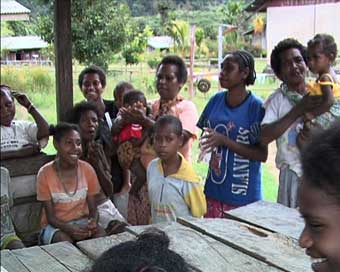
By involving the entire community, the HIV education campaign has become a local effort.
Like many young people, 19-year-old Rifal* never used to worry about AIDS. He saw it as a problem that only affected high-risk groups, such as intravenous drug users. His view changed in February 2006, when he learned he was HIV positive. Rifal hasn’t told his family or friends of his status. He fears being stigmatized. The only place he feels comfortable discussing his condition is at a clinic, where he receives medical and psychological care.While AIDS affects all of Indonesia, in Papua the proportion of people living with HIV relative to the total population is well over 10 times the national rate.
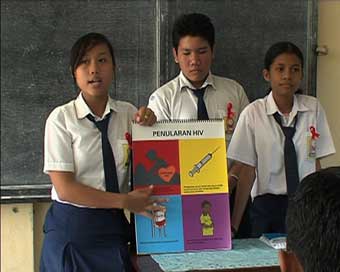
Through the campaign, peer educators in Papua are teaching students about HIV before they become sexually active.
To stem the tide of transmission, a programme supported by UNAIDS Cosponsor organization UNICEF is educating young people in Papua about HIV. The goal of this campaign is to promote awareness in the classroom and train young people to serve as peer educators. In addition to visiting older students, UNICEF is working to bring AIDS education to young people in junior high school – a critical time to reach out to young people on HIV and sexuality. The HIV education effort also aims to reach out to at least 10,000 young people who are no longer attending school. Peer educators visit local hangouts and areas on the beach that are frequented by young people who may no longer be in school and hand out booklets about AIDS awareness.As well as reaching out to young people, the programme also trains teachers to educate students about reproductive health and HIV.
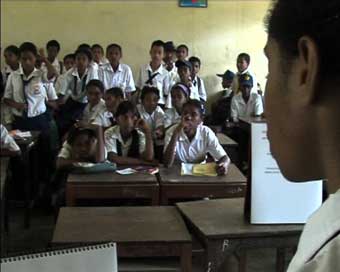
The HIV education campaign has become a local effort – with Papuans helping other Papuans to protect themselves.
Rifal believes this grassroots effort is needed to contain the spread of HIV. “Young people need to know more about using condoms and protecting themselves so that they don’t take risks,” he said. Sister Zita Kuswati, a Catholic nun in the regency of Sorong, has become one of the area’s most tireless and outspoken advocates in the fight against AIDS. As the leader of an HIV support group, Sister Kuswati believes information is power for young people.“We really needn’t be afraid of AIDS if we know how it is transmitted,” she said. “Students should be made aware of the method of transmission, the method of prevention and how people can be treated as early as possible.” “The epidemic in Papua is becoming more generalized, so raising awareness among young people is absolutely vital,” said Jane Wilson, UNAIDS Country Coordinator in Indonesia. “Greater education is helping young people make a difference within their communities and can help turn the tide on the epidemic.”
By Steve Nettleton, UNICEF. This story first appeared on the UNICEF web site www.unicef.org
*Name has been changed to protect identity
All photo credit : UNICEF Video
Related

Feature Story
Accountability; main message on World AIDS Day
20 October 2006
20 October 2006 20 October 2006
Marcel van Soest, Executive Director of the World AIDS Campaign
Executive Director of the World AIDS Campaign, Marcel van Soest speaks to UNAIDS about the history of the World AIDS Campaign, how people can become involved in this year’s events and why ‘accountability’ is such a crucial theme for World AIDS Day 2006.
Q: Could you tell us how and why the World AIDS Campaign was created?
A: The World AIDS Campaign has a long history, it was established by UNAIDS in 1997-98 when it was a part of the UNAIDS Secretariat. In 2001, there was huge concern within UNAIDS when AIDS appeared to be slipping off the political agenda. So UNAIDS held a number of consultations with different stakeholders, particularly with Non-Governmental Organisations (NGO’s), and came to the conclusion that the World AIDS Campaign needed to be strengthened and made into more of an independent campaign with greater civil society involvement and leadership.
So in 2004, exactly two years ago in September, the World AIDS Campaign was established as an independent campaign outside of the UN and outside of Geneva. UNAIDS of course still plays a strong supporting role but it no longer has a decision making role, this is now the job of the different civil society groups.
Q: How is the World AIDS Campaign governed?
A: For the last two years we have been working very hard on getting the right structure for the Global Steering Committee which now represents the different constituencies including internationally and globally organized actors with country memberships or country affiliates.
For example, the Global Union Federations which represent all the country trade unions all over the world are part of our Global Steering Committee. Faith-based and religious leaders, the youth movement and the women’s movement are also represented. As are the traditional actors in the AIDS response like the NGO’s and networks of people living with HIV. We are still reaching out to academics, researchers and the media who will hopefully join the Global Steering Committee shortly.
So these actors actually own the World AIDS Campaign and we are a small international support team that helps to strengthen mobilization and connect messaging from all the different campaigns on AIDS that exist at the international as well as the country level. We try to facilitate and contribute to a stronger social movement that is really needed to actually get things done in this world.
Q: How does the World AIDS Campaign decide on the themes for the campaigns?
A: The way that it works at the moment is that the International Support Team consults with all the different partners in the AIDS field from around the world to discuss the key issues throughout the year. We feed a lot of that information and insight into the discussions that are then brainstormed by the Global Steering Committee where all different constituencies of Civil Society have a seat and who then agree upon a strong theme.
This is how, two years ago, this Global Steering Committee adopted ‘Stop AIDS. Keep the Promise.’ as the focus, a tagline for the coming years, with the recommendation that there would be a variation on the theme each year for World AIDS Day. Last year the theme was ‘Make the Promise’ and this year it’s ‘Accountability’.
Q: Why is World AIDS Day such an important date in the yearly calendar?
A: World AIDS Day was introduced by the World Health Organisation on 1 December 1988. This was the first time that attention around the world was focused for one day in the year on AIDS. It provided a unique opportunity to highlight the seriousness of the epidemic.
Since 1988 World AIDS Day has developed into a huge event. It has become so big that in many countries it is no longer only just one day; but a whole week of events and activities. It starts with the launch of the new statistics in the AIDS Epidemic Update the week before World AIDS Day – and during the whole of the following week more and more events are taking place involving stakeholders from all over the world so it has become a very important day in the yearly calendar.
But of course one day a year is not enough, which is one of the reasons why the World AIDS Campaign was established to really look beyond World AIDS Day and keep the attention focused on AIDS issues and themes throughout the year.
Q: As you say, the theme of this year’s World AIDS Day is “Accountability”. What inspired this theme?
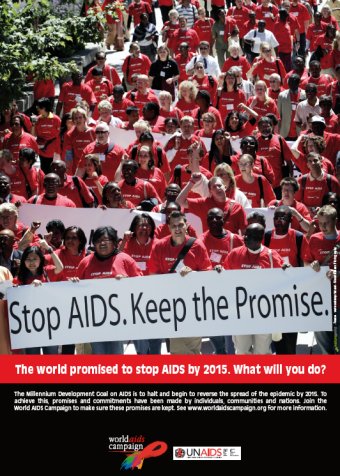
2006 World AIDS Day poster – part of the resource kit available from the World AIDS Campaign
A: Accountability came up in the discussions a year ago as 2006 is an important year in the AIDS response. A number of key events have taken place this year including; the High Level Meeting on AIDS, held at the UN in New York in June which was the five year review of the Declaration of Commitment on AIDS; the five year review of the Abuja Declaration in Africa; the Toronto AIDS Conference; and on the 14 November it will be five years since the Doha declaration was signed on access to generic drugs. 2006 also marked the 10 years of UNAIDS and the 25 years of AIDS.
2006 is a year of looking back to learn from the past and looking forward to see how to plan and strategise further on issues like Universal Access.
So having these important moments this year we felt that it was the right time and that focus was needed on accountability because of the strong significance this year holds in the AIDS response.
World AIDS Day is crucial for accountability because we know what works and we need to find out why programmes that work have not been implemented in light of Universal Access and country target setting. We want to make sure that the world is informed and aware and that all the leaders know that the public and civil society are watching and that we are very serious about all these promises.
Q: Who is the message of accountability targeted at this World AIDS Day?
A: This message is for all kinds of leaders from all the stakeholders including civil society and the business sector, the multilaterals like the UN and all the governmental leaders. It ranges from the top influential leaders, like the leaders of the G8 for example, right down to local community leaders so that grassroots groups can really look at promises and commitments that leaders have made and make sure that they are held accountable. It’s really to show that these promises are now being monitored and that they must be kept.
Q: The theme is a continuation of last year’s theme – is this a long-term campaign?
A: ‘Stop AIDS. Keep the Promise.’ is a tagline that we want to keep at least until the end of 2010, because of the Declaration of Commitment targets as well as the Universal Access commitments for 2010. We will be reviewing whether the same tagline will continue until 2015 in line with the UN Millennium goals or whether we will change to another tagline. But for now World AIDS Day each year will have different variations of the theme whilst keeping the tagline ‘Stop AIDS. Keep the Promise.’
Q: How can organizations and individuals become involved in this year’s World AIDS Day activities?
A: People can get involved in many different ways. For example on the World AIDS Campaign website we have a calendar where more and more organisations are now listing information on their planned activities for World AIDS Day.
So people can have a look at the website to find out what’s happening in their country or in their region. If they can’t find an event near to them there is also a partners page where all the World AIDS Campaign partners in countries are listed so that people can contact them to find out more. People can also contact their own local AIDS organisations, see what’s happening locally and find out how they can engage in events or offer their support.
We try to make sure that organisations are linking up locally with other organisations so that at least there is some kind of communication between the different organisations to enable them to link up together afterwards and combine their efforts.
If people or organisations want to set up their own events on World AIDS then we have a range of resources available to them on the World AIDS Campaign Website. For example we have a CD-Rom that provides ideas and gives information on what different groups are doing on World AIDS Day. We have designed a model this year using the colour red and on the CD-Rom there are all kinds of ideas about how they can organise a simple event using the colour red to target leaders on accountability issues.
Q: Are there any other materials you can provide people with who are planning to hold an event on World AIDS Day?
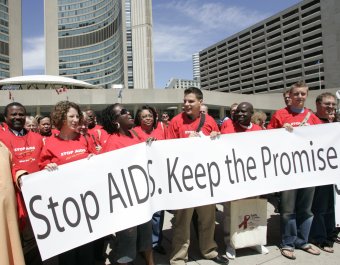
Faith pre-conference attendees march in support of “Stop AIDS. Keep
the Promise during AIDS 2006 in Toronto” from the
World AIDS Campaign Credit: Stuart Nimmo
A: This year we have more resources available than any previous years. We have posters which are designed in such a way that they are easily adaptable to include local relevant key messages as the wording and even the pictures on the posters can be changed or modified for the countries that have the resources to print them locally.
The printed posters and CD-Roms are partly being distributed by the WHO/UNAIDS distribution system but can also be ordered from the World AIDS Campaign website where the International Support Team will send the packages.
The posters come with the CD-Rom which contains information on possible topics and messaging for World AIDS Day and has a full spectrum of ideas for events and what different groups like faith, labour or NGO’s are doing on the day. We also have PSA’s, videos and photos available.
Q: How can people share information about their events?
A: People can post information about their events on the WAC website. If they go to the home page and click on the WAD 2006 Events calendar there is a form which they can fill in directly on the website, through this they can post their own text and photos on the site.
Beyond the events page they can always send further campaign information to the World AIDS Campaign helpdesk at info@worldaidscampaign.org and we will be happy to post on the website for them.
Q: What are the plans for next year?
A: We are currently having discussions for on the plans for next year, but we are hoping to make it bigger and better than ever. We are planning to adapt the theme locally as we would like to stimulate and bring resources for materials for posters, CD-Roms to the sub-regional level.
We want to give people information on how events can be organised jointly between, for example, trade unions, religious leaders and networks of people living with HIV. We are very keen on the idea of joint messaging and are looking forward to developing a great range of materials for next year’s events.
Keep checking our website for more information as the plans develop!
Links:
World AIDS Campaign
http://www.worldaidscampaign.info/
More on World AIDS Day 2006
http://www.worldaidscampaign.org/wadcd2006/en/day.html
Download materials and resources for World AIDS Day 2006
http://www.worldaidscampaign.info/index.php/en/resources/world_aids_day_resources
Related

Feature Story
UNAIDS Special Representative Mary Fisher honored
16 October 2006
16 October 2006 16 October 2006Dr. Jane Aronson, founder and executive medical director of the WWO,
honors Mary Fisher with the organization's second annual Orphan
Ranger Award.
On 16 October, the Worldwide Orphans Foundation (WWO) honored UNAIDS Special Representative Mary Fisher in recognition of her longstanding AIDS efforts, particularly as a determined advocate for women and children living with and affected by HIV worldwide. Ms. Fisher was honored at the WWO's Second Annual Benefit Gala held in New York City.
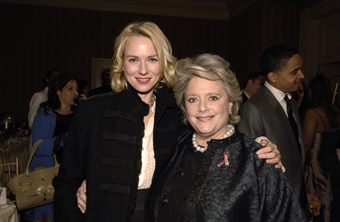
UNAIDS Special Representatives Mary Fisher (right) and Naomi Watts
The event was emceed by Whoopi Goldberg, the prolific actress and comedian, and Katie Couric, anchor and managing editor of the CBS Evening News with Katie Couric, raised millions of dollars to support the WWO's ongoing work on behalf of children orphaned by AIDS and other circumstances, and was attended by many notable figures, including UNAIDS Special Representative and renowned actress, Naomi Watts.
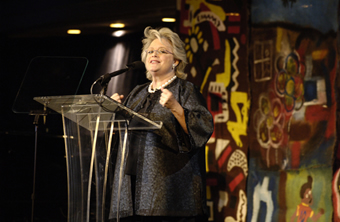
UNAIDS Special Representatives Mary Fisher
Since her appointment as UNAIDS Special Representative in May 2006, Ms. Fisher has undertaken UNAIDS fact-finding missions to Zambia and Rwanda, highlighting the socio-economic impact of HIV on women and girls.
In addition, Ms. Fisher has recently spoken at a number of high-level U.S. and international fora, including at the historic 1 June "Evening of Remembrance & Hope: Uniting the World Against AIDS" in the UN General Assembly Hall, sounding an urgent call for greater attention and action in the global response to AIDS.
All photos credits : UNAIDS / W. Lee
Related links
![]() Press Release: Worldwide Orphans Foundation Raises over $1.2 Million
Press Release: Worldwide Orphans Foundation Raises over $1.2 Million

Feature Story
UNAIDS Executive Director visits Japan
12 October 2006
12 October 2006 12 October 2006The Department of Global Health and Socio-epidemiology at Kyoto University has become a ‘UNAIDS Collaborating Centre’, following a signing ceremony between the Joint United Nations Programme on HIV/AIDS (UNAIDS) and the Kyoto University that took place in Japan on October 12th 2006.

Peter Piot delivers keynote speech at the University of Kyoto: “25 years of AIDS: tracing the history and looking forwards”.
As UNAIDS Collaborating Centre, the department will make an important contribution to the global and regional promotion of HIV prevention efforts, using its innovative methodological approach called "socio-epidemiology", which integrates qualitative with quantitative methods, and sociological with epidemiological viewpoints and draws upon considerable experience and accomplishments in researching on sexual behaviours and HIV intervention.
The collaboration with UNAIDS aims to strengthen HIV prevention among people most at risk of HIV infection in developing countries, East Asia and Japan, with a particular emphasis on youth.
To achieve this goal, the collaboration will focus on four key areas:
- Research - supporting policy making by means of facilitating socio-epidemiological research on HIV prevention in developing countries, East Asia and Japan
- Training - Training personnel capable of creating culturally appropriate prevention programmes drawing upon the socio-epidemiological approach.
- Communication - Accumulating the evidence for HIV prevention practice and communicating this worldwide
- Networking - Facilitating HIV prevention networking in East Asia.
The Collaborating Centre will be headed by Dr Masoko Ono-Kihara, a leading socio-epidemiologist and a founder of the ‘Wellbeing of Youth in Social Happiness’ model for HIV prevention among young people.
UNAIDS Executive Director Peter Piot welcomed the collaboration at the ceremony in Kyoto marking the signing of the agreement where he delivered a keynote speech on “25 years of AIDS: tracing the history and looking forwards”.
Dr Piot was visiting Japan to meet with senior officials from the new Japanese administration including Mr Takeshi Iwaya the new Senior Vice Minister in the Ministry of Foreign Affairs and with Congressman Mr Keizo Takemi.
UNAIDS Collaborating Centre is a non-UN entity that has been designated by the UNAIDS Secretariat to carry out specific activities in priority areas of the Secretariat or the response to HIV/AIDS epidemic. Collaborating Centres have clearly defined deliverables and timelines and contribute significantly to global or regional efforts.
- Following a consultative process with the UNAIDS Secretariat, the Collaborating Centre functions can include:Promote, support and implement relevant research, and disseminate and utilize the results of such research;
- Provide selected support targeted at strengthening national capacities for an expanded response to HIV/AIDS, especially in developing countries;
- Organise international learning events, policy dialogue, produce or review guidelines and other documents;
- Participate in technical resource networks established by UNAIDS Secretariat for the identification, collection and dissemination of best practices, and provision of technical support.
Related

Feature Story
UN General Assembly discusses Violence against Women
10 October 2006
10 October 2006 10 October 2006In early October the advancement of women was debated at the 61st session of the United Nations General Assembly. One of the most critical items on the agenda was the Secretary-General's in-depth study on all forms of violence against women.
The study highlighted that for many women worldwide, the threat of violence exacerbates their risk of contracting HIV. Fear of violence prevents women from accessing information on HIV and AIDS, being tested, disclosing their HIV status, accessing services for the prevention of HIV transmission to infants and receiving treatment and counseling, even when they know they have been infected. Studies show the increased links between violence against women and HIV and demonstrate that HIV infected women are more likely to have experienced violence, and that women who have experienced violence are at higher risk for HIV.

Credit: UNAIDS/L.Gubb
The paper was prepared at the request of the UN General Assembly. It discusses the causes and consequences of violence and lists a series of recommendations for action at national and international level, including by United Nations bodies themselves.
“The study exposes critical gaps in current efforts to address violence against women,” said Purnima Mane, Director of UNAIDS’ Policy, Evaluation and Partnerships Division. “Although the world is now paying more attention to women’s rights in general, it has made pitifully little progress in reducing violence against women. And this is impacting seriously on our ability to get ahead of the AIDS epidemic.”
“The UNAIDS-led Global Coalition on Women and AIDS has made reducing violence against women one of its top priorities,” said Violeta Ross Quiroga, a member of the Global Coalition’s Leadership Council. “Wherever you find violence – whether it’s physical, psychological, or sexual – there will be AIDS. HIV entered my life through violence, as it has for so many.”
This week’s General Assembly discussion and the Secretary General’s study offer an opportunity to strengthen work on the linkages between violence against women and HIV. The study calls on States to integrate efforts to prevent and reduce violence against women into HIV programmes. It calls on the UN system to clearly identify how violence against women affects the effective implementation of their mandates, and to link their response to such violence to their work on issues such as HIV and AIDS, poverty eradication, food security, humanitarian responses, health, education, legal and judicial reform or crime prevention.
Related

Feature Story
Amazonians unite to fight stigma in Brazil
04 October 2006
04 October 2006 04 October 2006Stigma and discrimination against people living with HIV is commonplace in the Amazon region of Brazil. In an effort to change attitudes and increase awareness about AIDS, people living with HIV in the heart of the Amazonian territory have come together to try to encourage people to learn about the epidemic and break down AIDS-related stigma.
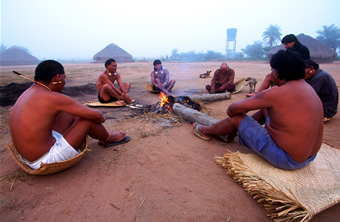
Credit : UNDP/C. Goldgrub
RNP+ is providing support to native Amazonians living with HIV
“In the northern region of Brazil, living with HIV is very difficult,” said Laurinha Brelaz, who has been HIV-positive for 13 years. “It is hard to get information, to show our faces and be open about our HIV status. The afro-Brazilian, native indigenous and Amazonian river people living with HIV are in constant fear of discrimination and stigma,” she explained.
Mrs. Brelaz is a member of Rede Nacional de Pessoas Vivendo com HIV/AIDS (RNP+), a Brazilian network of people living with HIV, based in São Paulo. RNP+ was created more than ten years ago and began working in the Manaus area of the Amazon State last year. The network seeks to support people living with HIV and focus on HIV prevention projects for native Amazonians.
“We want to support the Brazilian government in building public health policies. In the Amazon State, many people living with HIV are mistreated by public health staff. There are many cases of discrimination, especially towards HIV-positive women who particularly suffer prejudice. If we raise awareness about HIV in public opinion, people living with HIV will be confident enough to show their faces as part of society,” affirmed Mrs Brelaz.

Credit : UNICEF/BRZ/J.Simões
Native Amazonians often live in remote areas with little or no access to health care systems
According to a Brazilian Health authorities report, AIDS incidence in Amazon State increased from 3.7 cases per 100,000 inhabitants in 1994 to 15.7 in 2004. “In the Northern states the biggest challenges are related to access to health services. This is mainly due to geographical obstacles, and the need to expand the structure of health services to treat the local population. In order to strengthen the response to AIDS in the region, we need to improve health care systems, and encourage the involvement of civil society organizations,” said Mrs. Mariangela Simão, Director of the Brazilian National Programme on Sexually Transmitted Diseases and AIDS.

Credit : UNICEF/BRZ/J.Simões
By 2004, AIDS incidence had grown to 15.7 cases per 100,000 inhabitants in the Amazon state
The response to AIDS in the Amazon also goes beyond health issues. Recently RNP+ Amazonas mobilized civil society to participate in a Workshop for Awareness of Social Actors on HIV/AIDS sponsored by UNAIDS and ILO. “In the Amazon, there is a great opportunity to scale-up access to services for people living with HIV. A successful response cannot be achieved without the full engagement and participation of people living with HIV,” said Dr. Laurent Zessler, UNAIDS Coordinator Brazil. This partnership aims to develop actions on HIV in the workplace, including support to workers living with HIV in the Amazon region. The participants received information and material on HIV from UNAIDS, ILO, the Brazilian National Programme and various NGOs. The project also received support from local and State governments and National Trade Unions in the region.

Credit : L. Brelaz
Laura Brelaz, member of the Brazilian network of people living with HIV - RNP+
Partnerships between domestic and international actors are becoming increasingly fundamental to working on AIDS issues in inland Brazil. Mrs. Laurinha Brelaz represents the network of people living with HIV in the UN Expanded Theme Group on AIDS. “In the beginning of the epidemic, people living with HIV used to feel very alone. Nobody knew what HIV or AIDS was. So, people living with HIV built-up this network. Today, we are known internationally,” she explained proudly. “Our goals are to fully participate in the decision making at all levels, including state and municipal health councils and AIDS commissions, in order to build health policies together, fight for a high quality public health system and restore our dignity,” she said.
The work, led by Brazilian civil society in the Amazon region, still depends on strengthening their financial sustainability. “Financial issues are still the main obstacle we need to overcome. We are receiving some resources from National and local governments, but we intend to approach international sponsors as well,” Mrs. Brelaz highlighted. When asked about plans for the future, Mrs. Brelaz answered, “In the Amazon we intend to implement the same standard of quality of life for people living with HIV as in other areas of Brazil.” Now RNP+ Amazonas are planning for the next annual meeting of people living with HIV in the region.
Related

Feature Story
Emerging epidemics in Eastern Europe on the agenda
28 September 2006
28 September 2006 28 September 2006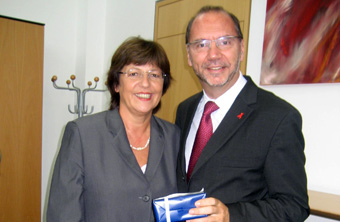
Ms Ulla Schmidt, Federal Minister of Health of Germany welcomes Dr Peter Piot, Executive Director of UNAIDS
The emerging epidemics in Eastern Europe and Germany’s commitment to increasing HIV awareness were one of several topics under discussion with German Health Minister Ms Ulla Schmidt and Dr Peter Piot the Executive Director of UNAIDS. On his recent trip to Germany he also met with the Health Committee of the German Federal Parliament, the State Secretary and Parliamentary State Secretary, the National AIDS Council. Dr Piot also met with the Minister for Cooperation and Development, Ms Wiezcorek-Zeul to talk about the importance of keeping AIDS high on the agenda during Germany’s presidency of the G8 in 2007.
UNAIDS Executive Director was in Germany from 26-28 September to participate in a range of meetings to discuss ways forward and continued commitment to the AIDS response.

The visit kicked off with a meal at the Kaffee Graefe, a café in Berlin run by people living with HIV. The café is part of a project to train people living with HIV, particularly migrants, to give them skill sets which will help them to integrate more easily into the workplace. As well as the café there is a successful catering business where people are trained in cookery and catering, waitering and waitressing, and small business management. Dr Piot was joined for the dinner by representatives from the German AIDS organisations Deutsche AIDS Hilfe, Aktionsbündnis AIDS, Seutsche Siftung Weltbevölkerung, Deutsche AIDS Siftung and Positive Aktion, to exchange views and discuss AIDS related issues and concerns.

(left to right): Mr Gernot Erler, Minister of State at the Federal Foreign Office, Germany; Dr Peter Piot, UNAIDS Executive Director; Dr Christoph Zöpel, President of the German United Nations Association, Deutsche Gesellschaft für die Vereinten Nationen DGVN at an event organized by the German United Nations Association and the Federal Foreign Office of Germany.
Highlighting UNAIDS as a test case for UN reform, Dr Piot presented at an evening event organised by the German United Nations Association and the Federal Foreign Office of Germany.
On the last day, Dr Piot met with the Head of the Office of the Federal President and the Committee for Economic Cooperation and Development. He wrapped up the visit with discussions on ways of building on existing partnerships in countries with the Managing Director of the German development agency GTZ and German development bank KfW.
Related links
View photographs from Executive Director's visit to Germany
Kaffee Graefe

